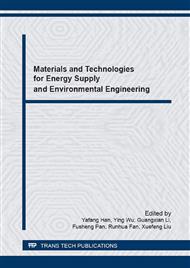p.299
p.308
p.315
p.321
p.328
p.335
p.344
p.352
p.358
Life Cycle Environmental Impact Assessment of Amorphous Alloy Strips Production
Abstract:
Amorphous alloy strips has been widely used in the field of distribution transformers due to its good soft magnetic properties. The resources, energy consumption of the amorphous alloy strips production with the rapid solidification technique and the environmental impacts were calculated based on the life cycle assessment method. The results showed that the largest contribution to the non-renewable resource consumption was ferroboron production process, accounting for 98% of abiotic resource depletion (ADP). And the strip production process had the largest contribution to the global warming potential (GWP), acidification potential (AP), photochemical oxidation potential (POCP), human toxicity potential (HTP),eutrophication potential (EP). Ferroboron production process contributed the biggest environmental impact when producing 1 ton amorphous strip, accounting for 70% of the total environmental impact. Under the new technology for energy-saving and emission-reduction, when the utilization rate of boric acid increased in ferroboron production process, all the environmental impact decreased.
Info:
Periodical:
Pages:
328-334
Citation:
Online since:
March 2016
Authors:
Price:
Сopyright:
© 2016 Trans Tech Publications Ltd. All Rights Reserved
Share:
Citation:


